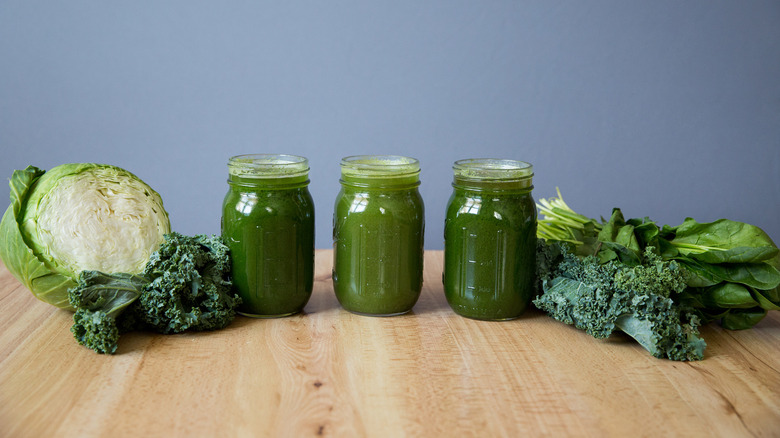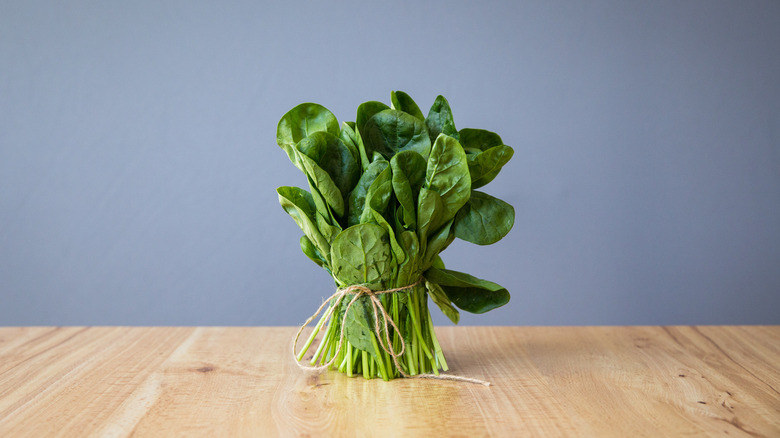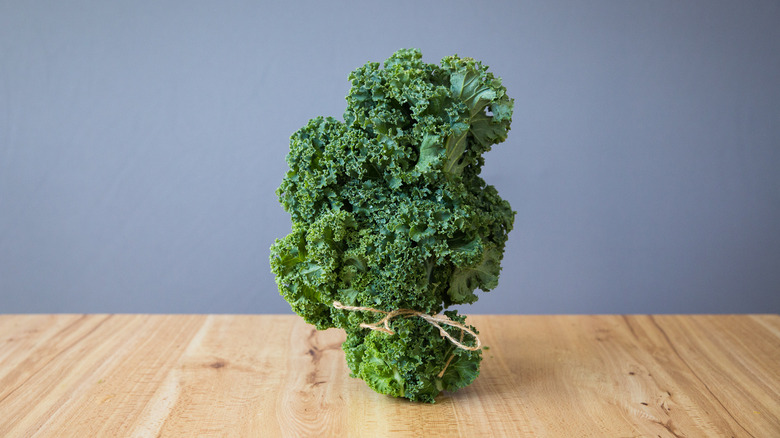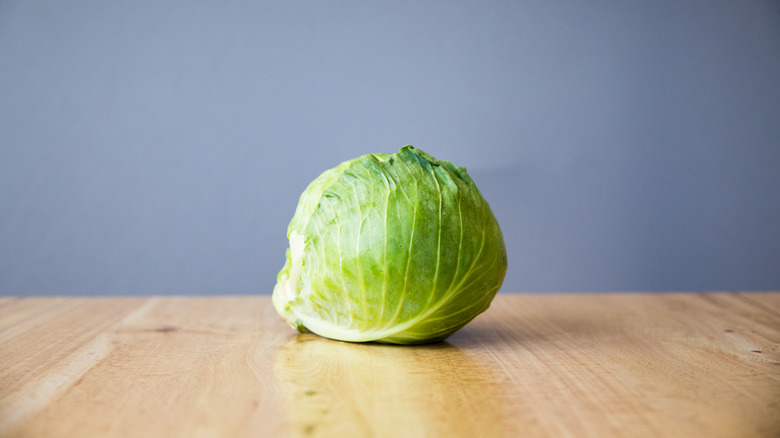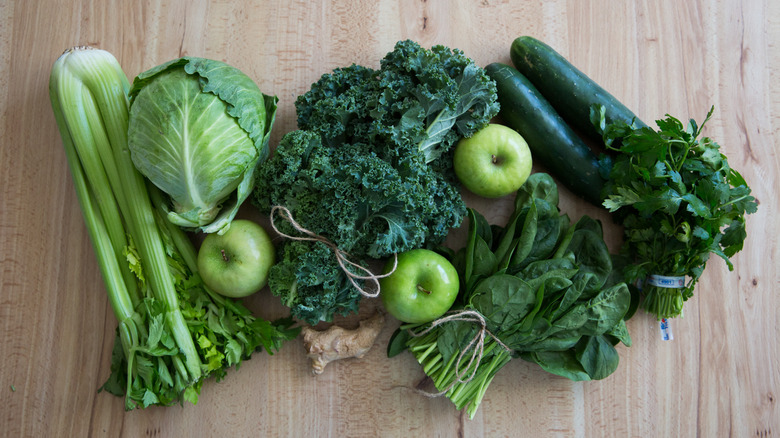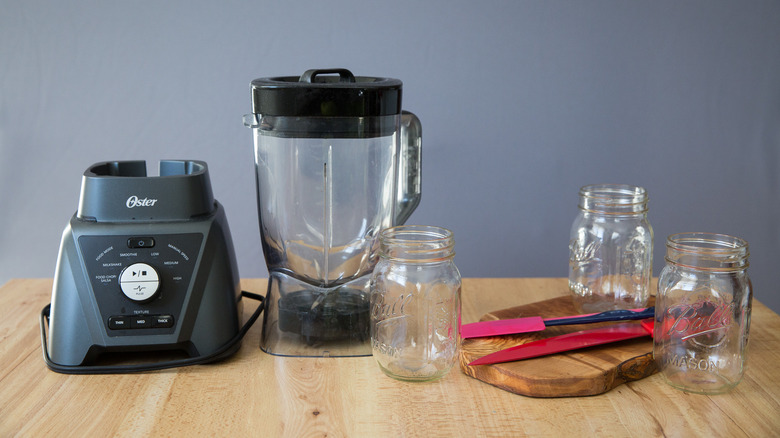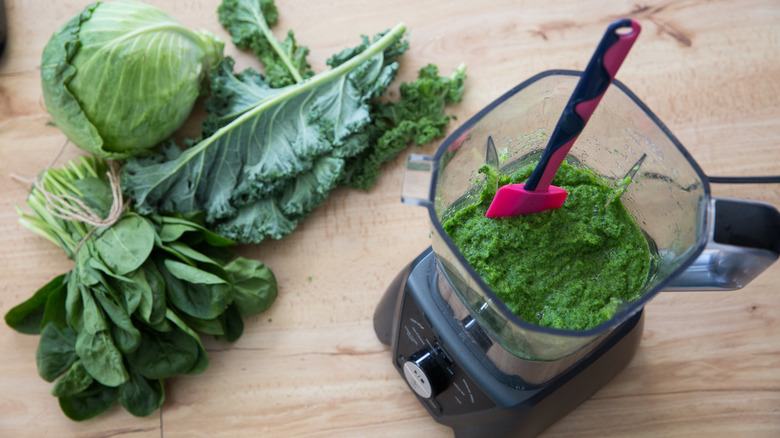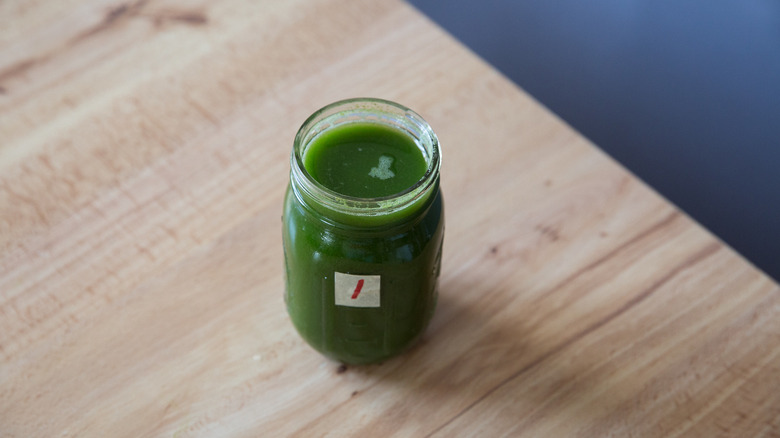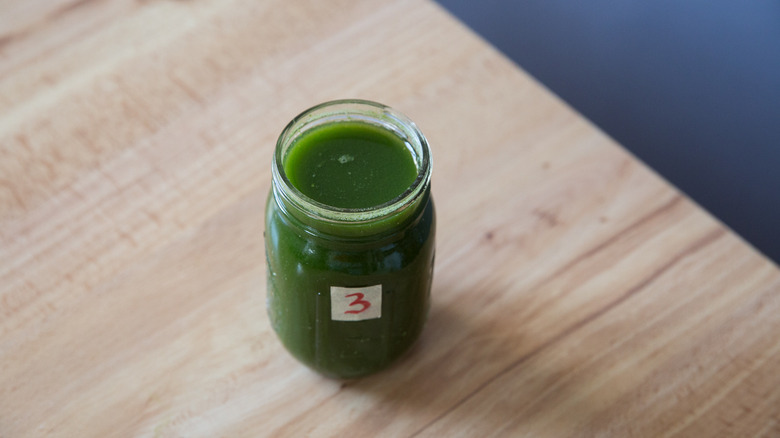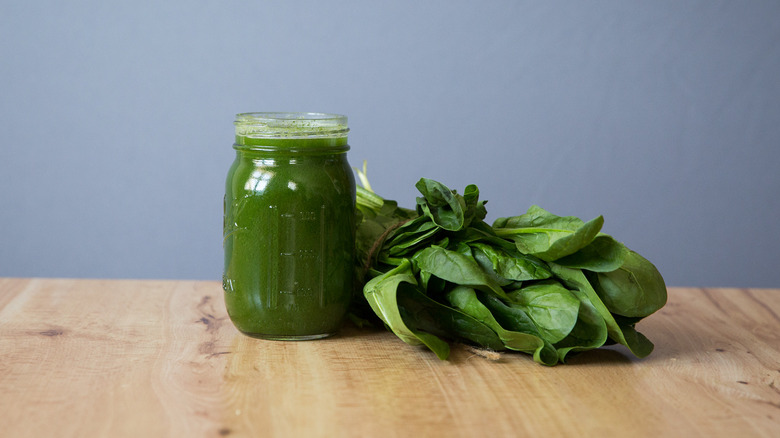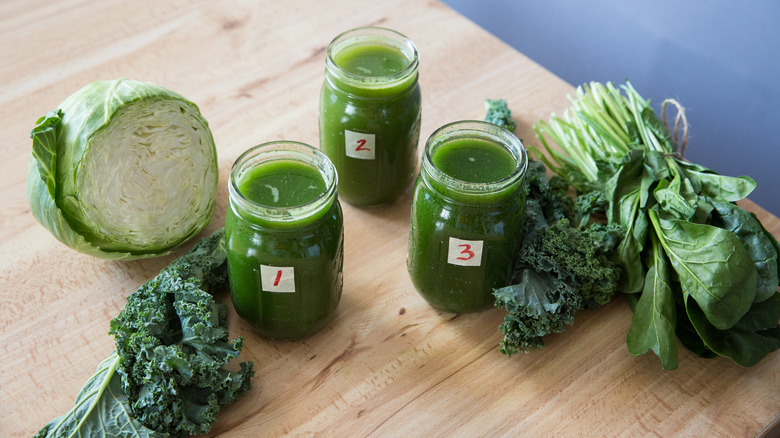Spinach Vs Kale Vs Cabbage: Which Leafy Green Tastes Best In Green Juice?
Green juice quickly became a popular health trend after it surfaced as a delicious drink with miraculous health benefits. While its effects on health are likely an exaggeration, the vegetables in green juice have been connected to positive outcomes like improved mental health, better digestive health, a stronger immune system, and reduced inflammation. (Although nutritionists point out that these effects are no stronger than those we can get from whole vegetables.) Either way, green juice can still be appreciated as a fresh and nutritious treat. This drink is simple to make at home with a few basic ingredients and tools. Homemade green juice is not only nutrient-packed, flavorful, and visually appealing, but has a delightfully fresh taste you can't buy in a bottle.
Leafy greens are the star of green juices. They're generally mixed with a few other vegetables and fruits like celery and apple, or herbs as we see in this crisp and gingery green juice recipe. If you aren't sure which greens to use, we did some work for you by testing juice made with three popular leafy greens — spinach, kale, and cabbage — to find out which one contributed the best taste to the final product. We made separate batches of green juice with spinach, kale, and cabbage, keeping the other ingredients the same, and set up a blind taste test. Our rankings were based on taste, texture, and the ease with which we were able to make each juice.
Spinach is widely available and easy to juice
Spinach is a popular and widely available leafy green vegetable that provides notable health benefits, as all edible leafy greens do. In fact, according to Consumer Reports, a CDC study of 50 vegetables and fruits found that of the top 20 most nutrient-dense kinds, 17 were leafy green vegetables. Raw spinach is high in B vitamins, potassium, and vitamins A, E, and K. Vitamin C is needed to help your body absorb the nonheme iron that spinach contains, so adding foods high in vitamin C, like bell peppers, citrus fruits, and strawberries, will be a beneficial, as well as tasty, addition to your juice.
While there are dozens of varieties of spinach that farmers grow, many regular markets only stock one to three kinds: Savoy spinach (also known as curly spinach), which has crinkly, tougher leaves; smooth leaf spinach, which is similar but has flat leaves; and baby spinach, which is sold in plastic bags and is a younger version of smooth leaf spinach. We chose smooth leaf spinach for the juice test because it's a common variety and its delicate leaves are easy to juice.
Kale is a superfood that makes a healthy juice
While all leafy greens are extremely healthy, kale often gets put in the spotlight and is named a superfood. It does deserve this reputation, of course, as it's full of vitamins A, B6, C, K, and folate, as well as zeaxanthin, a carotenoid that may be beneficial against eye disease, and glucosinaolate, which protects against cancer. Like all leafy greens, it's high in fiber, and as a cruciferous vegetable, it's known to improve immune function and lower blood pressure.
Curly kale, Dinosaur kale, and Russian kale are some of the more commonly available varieties. Curly kale has large, firm, medium green leaves with curled edges. It's usually described as having a peppery, slightly bitter taste. Dinosaur kale, also known as lacinato kale, Tuscan kale, or cavolo nero (which is also its name in Italian), is less bitter. It has large, flattened, dark green leaves with a texture like dinosaur skin (hence its name) and is popular in Italian cuisine. Russian kale may not be as easy to find. It's a sweeter vegetable with large, slightly curled leaves that can be tinged with red. We chose curly kale for this test because it's a common variety and is easy to find in American supermarkets.
Cabbage is lesser known but good for juicing
Cabbage isn't as widely seen in green juice recipes as kale and spinach, but there's no reason to stay away from this healthy vegetable when making juice. Like kale, cabbage is a cruciferous vegetable (like Brussels sprouts, arugula, bok choy, mustard greens, and collard greens, to name just a few other cruciferous leafy greens that could be juiced). Cabbage is especially high in vitamin C, an antioxidant that improves immune function. It contains several anti-inflammatory compounds and has been used as a traditional remedy for stomach ulcers. Healthline even reports that indoles, antioxidants in cabbage juice, were shown to kill breast cancer cells in humans.
Common cabbage varieties include green cabbage, which is shaped like a compact sphere and also known as cannonball cabbage; Savoy cabbage, which has a darker green color and textured leaves; red cabbage, which pretty much looks like green cabbage but is purple; and Napa cabbage, an elongated Japanese variety. There are many other varieties, some with colorful names like mammoth red rock cabbage or lunar cabbage. We chose green cabbage for this test because it's easily available and inexpensive. Despite its tough, compact leaves, it's easy to juice.
Ingredients you'll need
Green juice doesn't have to be complicated. If you prefer, you can make fancier versions featuring things like probiotics or extra protein, but it's possible to whip up a quick and easy version in just a few minutes, like a three-ingredient juice with carrots, apples, and spinach. Many popular green juice recipes have a few more ingredients than that while still keeping it pretty simple. The main ingredient you need is a leafy green. Kale and spinach are popular choices, but any leafy greens will work, including Swiss Chard and cabbage. Even salad greens go well in green juice. Adding other vegetables like celery, carrots, cucumber, or beets will give your juice more volume, flavor, and nutrition. Cucumber is especially good for juice because it contains a lot of water.
Fruits like apples, oranges, pineapple, or mango will make the juice sweeter and brighter. Some people like to add a little lemon or lime juice to this effect as well. Don't forget ingredients to add more flavor to freshly pressed juice, including ginger, spices, fennel, mint, and parsley. You can follow a green juice recipe or just choose a few ingredients you like and have available.
Green juice tools
The three main methods to juice fresh produce each have their own pros and cons. Steam juicing is generally used for large commercial production, but the nutritional content of the fruits and vegetables may be compromised. It lasts longer because the active enzymes are killed in the cooking process. Cold press juicing crushes the food to extract the juice. This can be as simple as squeezing a lemon or an orange by hand, or it can be done in an electric juicer. Finally, centrifugal juicing means blending the ingredients and then straining out the juice from the fiber.
To make the juices featured here, you can use a juicer for cold press juicing or a blender for centrifugal juicing, and they will both work well. Using a juicer is the most straightforward way. You don't have to chop the produce as small, and there are fewer steps. If you don't have a juicer, you can achieve the same effect by combining the ingredients in a blender (a food processor won't work) and then passing the mixture through a sieve or placing it in a thin cloth or mesh bag and squeezing out the juice. You'll also need a cutting board and knife, a spatula if you're using a blender, and containers such as glasses, cups, or Mason jars for serving or storing the juice.
How we make our green juice
Our focus was to evaluate green juices made with spinach, kale, and cabbage and decide which tasted best. We chose a basic green juice recipe and, besides the featured leafy green, kept everything else the same for all three tests. The other ingredients were celery, granny smith apple, cucumber, parsley, and ginger. We chopped everything into medium pieces and used a blender to make the test juices. One difference from using a juicer is we needed to add water to the blender to get everything moving, but this may not be necessary if you have a high-speed blender like a Vitamix. The other difference is you can cut the ingredients into larger pieces when using a juicer.
After blending, we poured the mixture into a mesh bag and squeezed the juice out of it by hand, discarding the drier, compact pulp that remained. Some people don't drink juice because they prefer to eat the fiber along with the liquid in fruit and vegetables. If this resonates with you, you can use the blender method but skip the straining step. The result will be more like a smoothie.
Taste test: Green juice with spinach
We tried our best to do a blind taste test of the three juices, and the jars were labeled and shuffled, but since they turned out to be different colors, there were still some unavoidable identifying factors. The first jar held the spinach juice. Green juice is visually appealing, and this was no exception. The spinach juice was opaque with a medium dark green color.
The flavor was fresh and balanced, without any distractions or overwhelming notes. All three juices had a mild taste and the same basic flavor, which is not surprising since they all followed the same recipe (except for which star leafy green was present), but the flavor of the ginger and parsley were a little more noticeable in this one.
Spinach created the smoothest blend right out of the blender, so texture was not an issue in the unstrained version. Because of the smoother texture, it was liquidy and easy to squeeze when straining. It produced the highest juice volume of the three after straining.
Taste test: Green juice with cabbage
The cabbage juice ended up in the second jar. This juice had the lightest color of all three. Our first impression after taking a sip was that of pleasant surprise. This juice had a light, bright taste that reminded us of citrus, even though no citrus was present in the recipe. We could see ourselves sipping this cold while relaxing outside in the summertime. It definitely did not taste like cabbage. We didn't know what to expect with this one, since cooked cabbage has a strong taste and smell, but that was entirely absent here.
Like its spinach counterpart, the unstrained cabbage version was very liquidy and without a rough texture, so it was easy to squeeze the juice out after making it in a blender. We got the lowest juice yield from this one. That's because of how we set up the recipe. To try to keep the taste levels the same, we weighed 3.5 ounces of each of the three greens; this was about half a bunch of spinach and half a bunch of kale, but only a small part of the cabbage head, since cabbage is so dense and compact. As a result, we got less juice.
Taste test: Green juice with kale
The third jar contained the kale juice, which had the darkest green color of them all. While all three juices had the same basic, mild flavor, the taste of this one was tiptoeing into a more pronounced flavor category. The juice had a bit of a heavier, almost bitter taste, which is typical for many kinds of kale. Don't get the wrong idea. The juice still tasted light and fresh, and if we hadn't just tasted the other two, we probably wouldn't have noticed.
The unstrained juice was definitely the most textured with more fibrous tiny pieces, so if you're making the smoothie version, you might need to add more liquid or use a high speed blender. We did cut away the thick central stems of the kale before blending. If you use a juicer, that won't be necessary. The liquid juice versions of all three remove the textured pieces and retain the original flavors.
Verdict: Did we prefer spinach, kale, or cabbage?
To be honest, the green juices made with spinach, kale, and cabbage tasted similar, since the base recipe was exactly the same. They were beautiful too. There was a little variation in lightness and darkness, but each had a vivid green color. They all tasted very good. Each one had a fresh, pleasant flavor we enjoyed. They also took about the same amount of effort to make, so just because we're giving them an order doesn't mean that any one of the three is bad. Picking the best one may be a matter of personal preference.
That said, based on this tasting experience, we chose spinach as the best leafy green for green juice. We felt like it had the most pleasing overall flavor, and it gave us a comforting feeling when we drank it. It was a close match with cabbage, which we put in second place, because of the cabbage juice's surprisingly bright notes. But since we can't declare a tie, the highest ranking goes to spinach because of its delicious, well-rounded flavor and lack of any particularly over-the-top notes.
Methodology
Our ranking decisions were mostly based on taste, but we also considered texture and how easy the juice was to make in a blender. Although many varieties of spinach, kale, and cabbage are grown, we chose a bunch of smooth leaf spinach, a head of green cabbage, and a bunch of curly kale because they are commonly found in local supermarkets. We made the three batches of juice in a blender and, since some people like to keep the fiber in their drink, tasted them twice — first in the textured, unstrained version, and then after straining the juice from the pulp.
We intended to do a blind taste test and set the tasting up accordingly by labeling each jar with a number from one to three and shuffling them after pouring in the juice. However, each juice had a slightly different color. The cabbage juice was the lightest, followed by the spinach, and the kale had the darkest green color. Since we were making the juice and doing the tasting, it was inevitable that we would see the colors, so despite our precautions, we knew what we were drinking. Still, we tried to be impartial. We enjoy eating leafy greens and like all three of the contenders, so we don't believe this influenced our ranking.
